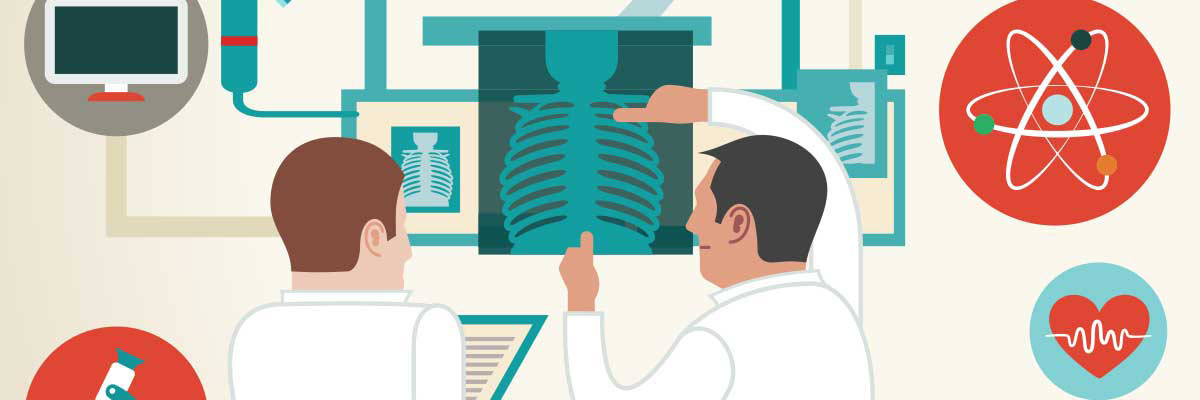<< All Articles
PERSONALIZED
MEDICINE
The pivotal role of
medical imaging

When you get an MRI, PET or CT scan, you're experiencing technologies that not only diagnose illness or injury but are helping develop cures for cancer.
Medical Imaging has given doctors and scientists a vision of the body's interior: the inner workings of our brains, the flow of blood through our hearts and the first glimpses of our unborn children.
Medical imaging also has a vision for the future. Radiologists today are collaborating with research scientists, engineers and other physicians on innovative techniques to treat, manage and predict diseases - from Alzheimer's to breast cancer.
New imaging technology is leading to better treatments
Detecting Difficult Tumors
Just as Polaroid's evolved into hi-res digital pictures, medical imaging has become amazingly precise and advanced. That means patients experience healthcare that is both less invasive and more accurate.
Historically, biopsy was the standard method for diagnosing prostate cancer. But the invasive method often fails to find elusive tumors. Enter multiparametric, MP-MRI, prostate imaging. By zeroing in on highly vascularized, tightly packed tissue - the hallmarks of a tumor - MP-MRI can "Locate, quantify and even assess the aggressiveness of prostate cancers,' says Raymond Murphy, MD- PhD, a radiologist with SMIL Imaging. "this non-invasive, 30-minure examination uncovers tumors in areas of the gland that are very difficult to find using standard biopsy technique,"
Even more recently, SMIL radiologists are teaming with urologists to implement MR-US Fusion when treating prostate cancer. The new technology marries MP-MRI images with real time ultrasound guided biopsy images. This allows urologists and radiologists to perform targeted biopsies on tiny or oddly located tumors, improving diagnosis and potentially helping develop new therapies.
New technologies are also helping radiologists spot hard to find breast cancers. SMIL was involved in the original trials of 3D mammography and was one of the first facilities in the country to offer this innovation. In Tomosynthesis, as it's officially called, the scanner moves in an arc, taking several images and synthesizing them into a 3D model. Radiologists examine the model layer by layer to peer behind structures within breast tissue and pinpoint hidden tumors. Studies have shown that 3D Mammography detects more cancers and results in fewer false alarms.
The Advent of Precision Medicine - Combining Forces to Combat Cancer
Just as a picture is worth a thousand words, "imaging is really a digital medium that has a lot of high-information content,' says Ronald Korn, MD-PhD, Medical Director of SMIL Research.
Using these information rich images, experts in the fields of radiology, oncology, and genetics are combining forces to develop individually targeted tumor therapies. Dr. Korn works at the center of these connected specialties, as Medical Director of the Virginia G Piper Cancer Center and of SMIL Research, as well as an adjunct faculty member at the Translational Genomics Institute. (TGen).
When you merge our imaging data with other data such as traditional clinical outcomes, Knor says, 'You start to get a more complete picture not only of tumor response to therapies which are more likely to respond to which therapies."
Through advanced imaging analysis, Korn adds, radiologists can track how cancers behave before and after treatment, monitoring the tumor's shrinkage or its resistance to drugs and responding quickly with alternative therapies. Using imaging, radiologists can in some cases even identify the individual genetic expression of various cancers.
Imaging can also enhance the development of drug therapies for cancer and other diseases. Currently it takes an average of 12 years for a newly discovered drug to reach the patient. And only one in five drugs that enters clinical trials advances to an approval stage. But by employing advanced imaging technologies - many of which are such as those used at SMIL in collaboration association with Imaging Endpoints, Research an independent imaging core laboratory-scientists can better identify which drugs should advance from animal to human studies, plus help doctors determine the appropriate dosage and regimen for patients.
No two tumors are exactly the same, and one patient's lung cancer may not behave the same as another's. Powerful image analysis can help us locate a tumor, as well as assess it's genetic and biologic nature, which influence its behavior and response to therapy. This truly transformative power of imaging in the clinical management of cancer patients is already within reach and will lead beyond current clinical trials to important improvements in diagnosis, drug development and individualized treatment, or 'precision medicine'